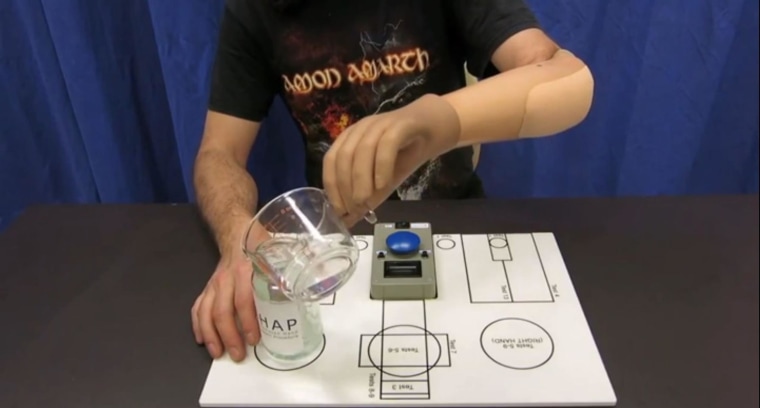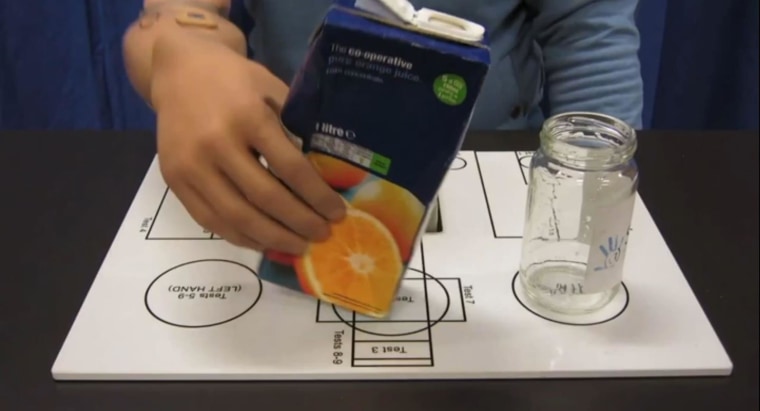Three men who had lost the use of their hands after accidents have been fitted with bionic hands using a new method to control an artificial limb, researchers said Tuesday.
The technique, called bionic reconstruction, could be widely used, the team of Austrian researchers report in the Lancet medical journal.
It’s allowed 30-year-old Milorad Marinkovic of Vienna to hold hands with both his young son and daughter at the same time as they cross the street or walk to the park. “Before, they used to have to take turns holding my hand,” Marinkovic told NBC News. “With my prosthesis, they both can at the same time.”
The new hands work well enough to let the men use buttons, pour water and handle everyday objects.

All three men volunteered to have their own lower arms and hands amputated and replaced with the prosthetic devices. Other surgical centers could learn the techniques, said Oskar Aszmann of the Medical University of Vienna, who led the team.
The three men had injuries that haven’t been treated before with prosthetic devices, which are usually used to replace amputated limbs. In this case, their lower arms and hands were immobile but intact.
Marinkovic was injured in a motorcycle accident, and another patient was also injured in a traffic accident. A third fell while climbing.
They all had a particular injury called a brachial plexus injury, said Dr. Aidan Roche, who helped lead the team. The brachial plexus is a bundle of nerves that controls the arm.
“The lower parts of these nerves were pulled violently out of the spinal cord,” Roche said. Their hands stopped working, they lost much of their sense of touch and pain, and one of the three men kept burning himself because his hand was numb.
“That damage cannot be repaired,” Roche said. “Those patients are left with a hand that’s useless.”
It was painful, too, said Marinkovic. “I had pain all the time,” he said. Multiple operations failed on all three men. Their muscles withered and contorted from disuse.
The trick was getting what little functioning nerve they had left to power the prosthetic arm and hand. The team did this by transplanting muscle from the inner thigh into the forearm. The signal was enough to decode and use to direct a battery-powered artificial forearm and hand.
“The real innovation here is the procedure itself,” Roche said.
The hardest part, Roche said, was training the patients before and after the surgery. They had to wait for months for the muscle transplant to completely integrate, then they learned how to twitch it to make a computer image change.
Once they could control the muscle, the prosthetic was attached next to their non-working hand, and they learned to control it. Only when they felt confident were their hands amputated so the device could fit more naturally, Roche said.
“They’re glad to have got rid of their useless limb,” he said.
“They’re glad to have got rid of their useless limb."
“When we did the amputation and I got the hand, it completely changed my life,” Marinkovic, an accountant, agreed.
His son, who is 8, likes it, too, he said. “He says ‘my daddy is Robocop and he is the Terminator’, Marinkovic said. “It is really funny.”
Many teams are trying to develop prosthetic devices that people can use naturally, without the heavy mechanical whirring that goes with most such devices.
Some veterans given mechanical prostheses say they can manage better without them, explaining that they are uncomfortable, unreliable and painful to wear regularly.
One team at Case Western University in Ohio is working to give a sense of touch to artificial limbs; others are working to make thought-powered devices.

"So far, bionic reconstruction has only been done in our center in Vienna. However, there are no technical or surgical limitations that would prevent this procedure from being done in centers with similar expertise and resources,” Aszmann said.